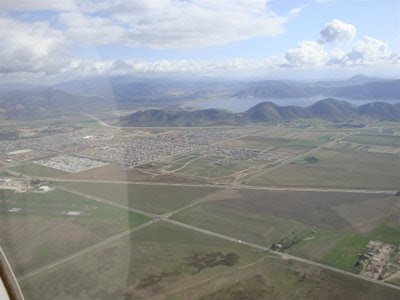Our club is beginning winch operations at our home airport, and this was week 2 of a 6-week startup and training program. The plan was to winch launch from 8 am until 11 am, before the commercial operation planned to start aerotowing. In the future we might be able to mix the two operations, but as we're starting up we need to stay well out of each other's way. I went to help out, and because I was hoping to do a soaring flight later in the day.
I did the job of "Line Boss" for a few launches, which involves coordinating the actions of the winch driver, wing runner, and pilot by radio. I've done this before at other club ground launch sites. I wasn't really planning to winch launch today, but a slot came open and I was up next. (I've winch launched a few times
before, actually have an endorsement for it, but it's been a while and I planned to do it again with an instructor.) But the commercial op asked us to stand down from 10 to 11 so they could do a few aerotows for the other club. And the other club guys pushed out at 9:58 just as I was ready to go. Argh. We backed off and let them go, and for various reasons that was the end of our winching for the day.
I was able to squeeze in an aerotow flight in the Blanik between a couple of student sessions (most of the other members had left). The weather was very cloudy, after a mild rainstorm yesterday, but the forecast and conditions indicated there might be some lift. (Frequently on a "post-frontal" day the air is unstable and good for soaring.) If trigger temperature was reached, the lift could be 3 to 4 knots. Unfortunately the clouds covered about 80% or more of the sky, blocking solar heating. There was a fairly strong southwest wind, 11 to 17 knots at times, which some said would destroy the thermals. Well, yes, it can destroy the
thermals, but it can also cause
orographic lift even away from obvious ridges. Fortunately I had been watching the sky carefully all day and it appeared to me that some areas in and near a "blue hole" were generating some lift, and I wanted to check it out. (I
really like to fly, even if it's a short flight.)
Of course, some big cumulus clouds are obviously directly caused by upslope winds over big mountains. And isolated puffy CU on a warm day can be obviously related to identifiable thermals. Smaller, near-overcast CU over a valley or area of hills can appear to be just floating by. But that's because the cloud motion and development happens on such a slow timescale that we humans don't easily see the patterns. If you watch some time-lapse movies of clouds, you can see that they are often developing in a fairly constant place, and then dissipating downwind and higher up. Not necessarily a
predictable place, but often a
noticeable place.

You have to watch the sky for a while to see that happening in real time. In this photo, those cauliflower-shaped clouds on the other side of the lake were always in the same place even though it was windy, indicating a fairly steady-state flow in what looks like a random pattern of clouds. It seemed to me that the "blue hole" (to the right of this view) was in a fairly constant place, and the little clouds in and around it were stable and some had concave bases, indicating strong lift.
So up I went. I asked the tow pilot to take me up near cloudbase in that specific area. As we approached that zone, we went through some areas of lift. I released at 2100' AGL near a decent cloud. AWOS was reporting the ceiling at 2400', but I think it was higher. I found some pockets of fairly constant lift of 300 knots (
correction: 300 feet per minute), with some short bursts of 6! The lift was small, too small to actually center. It was stronger under some of the big gray areas, but those clouds were fuzzy enough on the bottom that I didn't want to get too close. I never did get above release altitude (duh - there were clouds above me!) but I did play around with the lift for a little while. I also took some pictures, which probably contributed to my not staying in the lift very well. That was OK, because I knew there was a student waiting for me to come down. So I got an 18-minute flight. From a 2100' foot tow, a no-lift ride would be about 9 minutes.